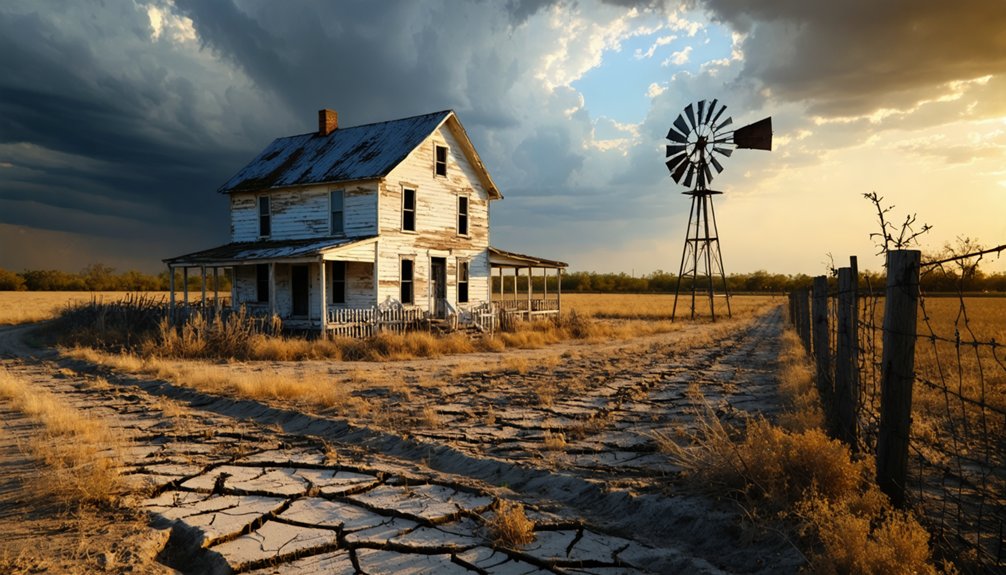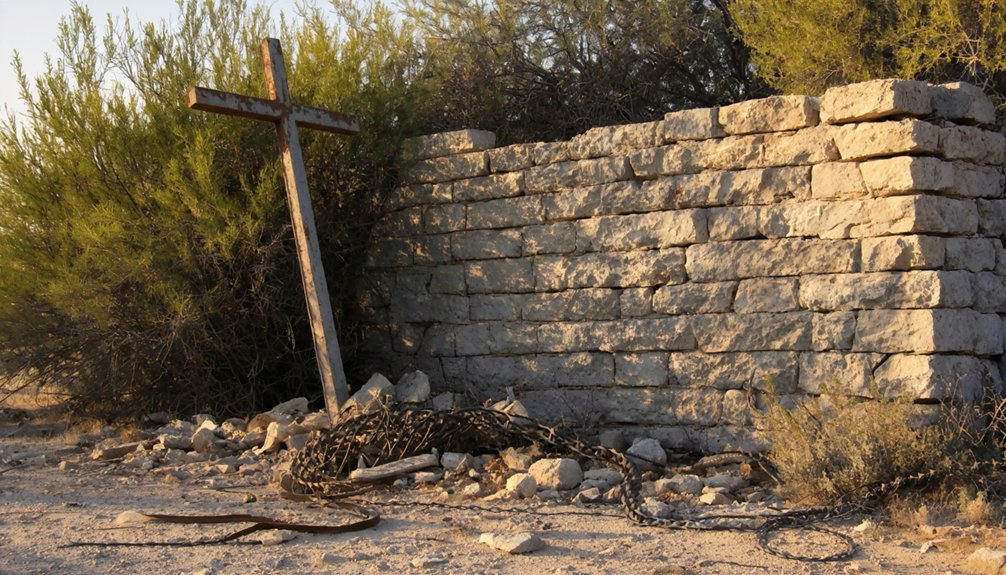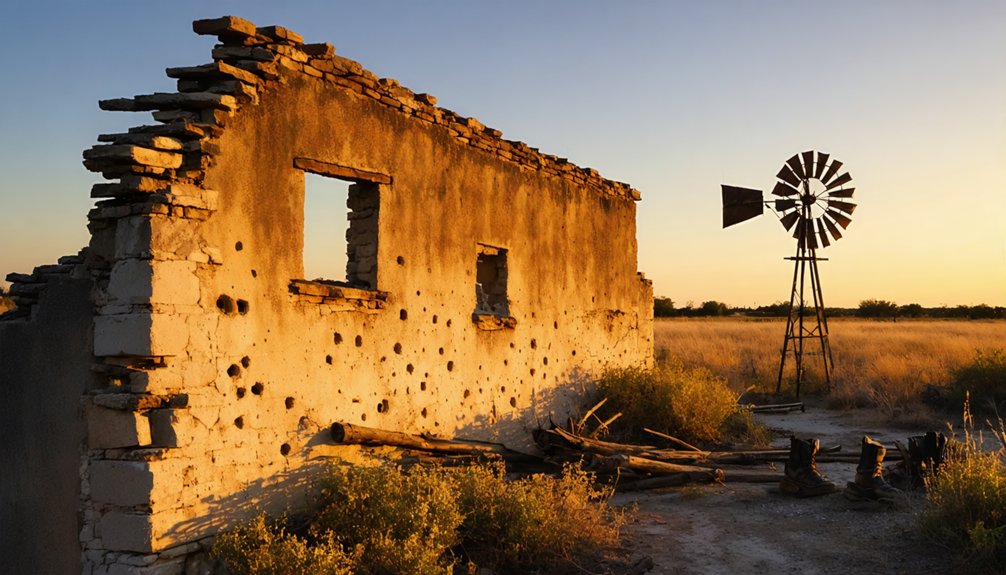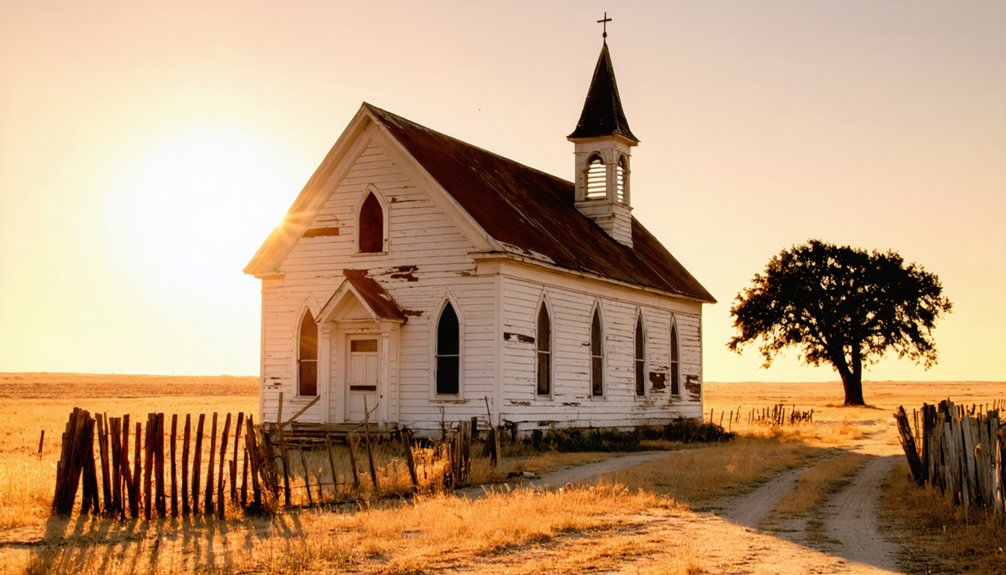You’ll find Casa Blanca’s origins in 1754 when Spanish colonist Tomás Sánchez built a distinctive square structure with a central courtyard from caliche blocks. This South Texas settlement thrived as a ranching operation and community hub under the Montemayor family until 1852, then under John L. Wade’s ownership from 1876. Economic challenges, droughts, and changing trade routes led to its abandonment, leaving behind rich archaeological remains that tell a fascinating tale of colonial Texas life.
Key Takeaways
- Casa Blanca, founded in 1754, was a Spanish colonial settlement featuring a distinctive white building that served as a ranching and community hub.
- The site declined in the late 19th century due to economic competition, changing trade routes, and geographic isolation.
- John L. Wade acquired the property in 1876, operating it as a ranch until 1973 before its eventual abandonment.
- Archaeological remains include over 20,000 house foundations, Spanish colonial architecture, and numerous artifacts from indigenous and settler communities.
- Environmental challenges, including droughts and freezes, combined with limited infrastructure, forced residents to relocate and abandon the settlement.
Origins in Spanish Colonial Texas
When Spain established its control over Texas in 1519 as part of New Spain’s viceroyalty, they implemented a systematic approach to colonization that would shape the region’s development for over three centuries.
You’ll find that Spanish missions became the cornerstone of colonial governance, serving dual purposes of religious conversion and territorial control. European diseases brought by Spanish explorers and missionaries decimated native populations in the region. The Crown’s strategy involved establishing presidios as military outposts to protect these settlements. The Franciscan order managed these missions to spread Christianity and Spanish culture throughout the region.
In 1807, the area that would become Casa Blanca emerged when the Spanish Crown granted land to Juan José de la Garza Montemayor and his sons.
Like many Spanish colonial settlements, this land grant reflected Spain’s method of establishing control through influential families who’d manage vast estates. These landholders became essential players in maintaining Spanish authority while developing the region’s ranching economy.
The Founding of Casa Blanca
The founding of Casa Blanca traces back to 1754, when a square building with a central courtyard was constructed from caliche blocks under the direction of Tomás Sánchez de la Barrera y Gallardo.
Just like its Spanish counterpart Casa Blanca, the name literally means “White House” in English.
The structure, which became known as the “White House,” featured a well that connected to an escape tunnel, and later served as a mission in the late 1700s.
The historic White House’s ingenious design included a well with a secret escape tunnel before becoming a Spanish mission.
The settlement history took a significant turn in 1807 when the Spanish crown granted the land to Juan José de la Garza Montemayor and his sons.
The Montemayor family maintained ownership of Casa Blanca until 1852, using it as their ranch house.
After their departure, the property changed hands, with John L. Wade acquiring it in 1876 and later establishing the adjacent Wade City.
The community’s rich history continued until sudden evacuation in 1894 forced residents to abandon their homes.
Life in Early Settlement Days
Life at Casa Blanca revolved around a bustling ranching operation that served multiple crucial functions in early Texas settlement days. You’d find sheep and cattle grazing near the San Antonio River, while the impressive stone ranch house stood as a beacon of civilization for weary travelers.
The property wasn’t just a working ranch – it was a crucial community hub where you’d encounter everyone from teamsters to prominent figures like Stephen F. Austin. The mansion served as a vital meeting place for Don Erasmo Seguin’s leadership and political activities.
You’d experience a blend of Mexican and Anglo cultural traditions during community gatherings, with ranching practices shaped by both influences. Extended families, servants, and seasonal workers lived together on the property, sharing outdoor living spaces like brush arbors.
The ranch’s strategic location near major travel routes made it indispensable for trade and transportation, connecting settlers to broader markets and opportunities. The Casa Blanca blockhouse later became home to the area’s first post office in 1852.
Native American Relations and Cultural Exchange
Before Casa Blanca’s establishment in 1754, you’d find diverse Native American groups in South Texas practicing Archaic cultural traditions modified by the introduction of bow and arrow technology.
These indigenous peoples established extensive trade networks and settlements along Peñitas Creek, though their distinct tribal identities were later obscured in Spanish colonial records through renaming and consolidation.
As Spanish settlers moved into the region, they initiated a complex power dynamic where native populations either resisted colonial expansion through conflict or gradually integrated into the Spanish mission system, leading to significant cultural exchanges in farming, ranching, and daily life. The area later became a site of conflict during the Great Raid of 1840, when Comanche warriors engaged in skirmishes with settlers at Casa Blanca Creek. Local legends tell how the hostile Indians eventually drove the Montemayor family from their home.
Early Indigenous Settlement Patterns
Long before European settlement transformed the Casa Blanca region, diverse Native American groups established complex settlement patterns along the Rio Grande Valley.
You’ll find evidence of tribal migrations that included the Jumanos, Coahuiltecans, and Grupos del Norte peoples who demonstrated remarkable cultural resilience through their adaptations to the landscape.
These groups maintained seasonal settlements that aligned with the region’s rivers and terrain, following traditional hunting and gathering practices.
The Northern Tamaulipas tribes shared related languages and cultural traits while remaining politically independent.
They’d create temporary camps that allowed them to take advantage of natural resources throughout different seasons. The groups relied heavily on mesquite flour and pecans as dietary staples.
Despite their small-scale political organization, these indigenous peoples developed sophisticated cultural patterns that sustained their communities for thousands of years. The Jumanos were particularly skilled at farming near rivers, cultivating corn, squash, and beans to support their communities.
Cross-Cultural Trade Networks
While Spanish colonization would later reshape the region’s dynamics, indigenous peoples of Texas had already established sophisticated trade networks spanning thousands of miles across diverse cultural boundaries.
You’ll find that tribes like the Caddo and Jumano developed complex systems for exchanging essential and luxury trade goods that connected the Great Plains, Eastern Woodlands, and Southwest cultures.
- Trade routes followed natural waterways and well-worn trails, with traders covering hundreds of miles on foot or by canoe.
- Valuable items included salt, pottery, bois d’arc wood, seashells, copper, and ceremonial objects.
- Cultural influences spread through these networks, shaping religious ceremonies and social structures.
- Trading centers served as diplomatic hubs where tribes forged alliances and negotiated treaties, laying groundwork for future colonial relations.
Spanish-Native Power Dynamics
As Spain’s influence expanded into Texas during the 16th century, the complex relationship between Spanish colonizers and native peoples shaped the region’s development through a series of shifting alliances, conflicts, and cultural exchanges.
Spanish Missions served as centers of power, but they couldn’t fully control tribes like the Comanches, Apaches, and Caddos. You’ll find that Native Resistance manifested through raids and broken treaties, while some tribes strategically cooperated with Spanish authorities for protection or trade benefits.
Disease devastated native populations, yet many tribes maintained their autonomy. By 1731, some Native families even gained control of San Antonio missions, though tensions persisted due to unfulfilled Spanish promises and military conflicts.
This power struggle continued until Spain’s rule ended, leaving a legacy of cultural adaptation and resistance.
Ranching Community Development
During the late 19th century, Casa Blanca emerged as a ranching community when John L. Wade purchased the land in 1876.
You’ll find the area’s ranching challenges shaped by the mix of Anglo and Hispanic ownership, where intermarriage became essential for ranch survival.
Community resilience showed through the Wade Ranch’s remarkable 96-year run from 1898 to 1973.
- Ranch headquarters served as significant community centers, bringing locals together beyond just agricultural activities.
- The area weathered severe freezes and droughts in the 1880s-1890s, forcing smaller ranchers to sell to larger operations.
- Water access proved imperative, with Las Frutas dam built in 1929 to support ranching needs.
- By 1945, state water demands led to flooding 2,600 acres of Wade Ranch land, marking a shift in local ranching dynamics.
Agricultural Challenges and Adaptations

The harsh realities of Casa Blanca’s environment shaped its agricultural destiny from the start. You’d find your crops struggling against caliche soil, a rock-hard calcium carbonate layer that blocked root growth and water infiltration.
The semi-arid South Texas climate, with its punishing droughts and high evaporation rates, made consistent farming nearly impossible. Early settlers tried crop diversification, mixing drought-resistant native plants with introduced grains, while implementing water conservation techniques through small-scale irrigation systems.
Despite these efforts, crop failures were common. Cotton and grain expansion attempts fell victim to the unforgiving soil and erratic rainfall. You’d see most farmers eventually shift to ranching, using the vast 70,848-acre land grant for grazing instead of crops.
This change to pastoralism proved more sustainable given the region’s environmental constraints.
The Path to Abandonment
While Casa Blanca initially showed promise as a frontier settlement in 1754, its path toward abandonment began taking shape by the late 19th century.
The town’s cultural heritage and economic resilience faced mounting pressures as younger generations sought opportunities elsewhere.
You’ll find that Casa Blanca’s decline accelerated through a series of interconnected challenges:
- Competition from nearby towns and changing trade routes diminished the settlement’s economic relevance
- The Great Depression struck a devastating blow to local agriculture and ranching operations
- Limited access to modern infrastructure and essential services pushed families to relocate
- Geographic isolation and water scarcity made agricultural sustainability increasingly difficult
Archaeological Discoveries

You’ll find extensive archaeological remains at Casa Blanca revealing both indigenous and colonial histories through carefully preserved artifacts.
The site’s hieroglyphics and sandstone carvings illustrate rich indigenous customs and beliefs, while tools and architectural elements showcase the interaction between native peoples and Spanish settlers.
The discovery of over 20,000 house foundations arranged around plazas and connected by streets demonstrates the settlement’s remarkable size and sophisticated urban planning during its peak occupation.
Pre-Colonial Indigenous Artifacts
Archaeological discoveries near Casa Blanca have revealed extensive pre-colonial indigenous settlements through diverse artifact assemblages. Shell artifacts and lithic technology found at workshop sites demonstrate sophisticated tool-making skills and trade networks. The evidence points to well-established communities that mastered both coastal and inland resources.
- Core-blade workshops contained imported stone materials and marine shell ornaments, showing extensive trade connections.
- Specialized shell-working produced disc beads, gorgets, pendants, and tools from whelk and conch shells.
- Stone points including Kent, Ensor, Perdiz, and Scallorn types indicate hunting was essential to survival.
- Workshop areas reveal curated stone materials and specialized tool production rather than casual discard, suggesting organized manufacturing.
These findings align with regional patterns seen in both Rockport and Brownsville archaeological complexes, indicating Casa Blanca’s role in pre-colonial trade networks.
Spanish Settlement Remains
Beyond the indigenous artifacts, Casa Blanca’s landscape reveals extensive Spanish colonial remains dating back to 1718.
You’ll find foundation ruins of mission complexes and presidios along the San Antonio River, showcasing early Spanish architecture designed for both religious and military purposes. These structures tell the story of Villa de Bexar’s transformation from a military outpost to Texas’s first legally recognized civilian settlement by 1731.
The colonial artifacts you’ll discover include farming tools from Canary Islands settlers, imported Spanish ceramics, and religious items like rosaries and crucifixes.
Archaeological evidence shows how the settlement evolved, from the planned town layout to the organized governance structures. Municipal building remains and civic records demonstrate Casa Blanca’s role in establishing Texas’s first official civilian government, marking a pivotal moment in colonial history.
Preservation of Historical Legacy
While many Texas ghost towns have faded into obscurity, Casa Blanca’s historical legacy endures through multiple preservation channels. Historical documentation, from Spanish land grants to scholarly theses, provides a solid foundation for understanding the town’s evolution.
Community engagement through local historical societies and volunteer efforts keeps the site’s memory alive.
Dedicated volunteers and historical organizations work tirelessly to preserve Casa Blanca’s rich heritage for future generations.
- Early records include the 1807 Spanish crown land grant to Juan José de la Garza Montemayor
- Original caliche block house foundations and Methodist church structures remain as tangible links
- Cemeteries with headstones of mining immigrants and settler families tell personal stories
- Digital preservation through the Handbook of Texas Online and social media platforms guarantees modern accessibility
State historical associations and parks departments continue to provide oversight, while universities contribute through research and archaeological studies.
Similar Ghost Towns in South Texas

You’ll find several ghost towns similar to Casa Blanca scattered across South Texas, including abandoned ranch communities like Darwin and Spanish settlement remnants near historic trade routes.
Many of these sites share Casa Blanca’s pattern of initial prosperity followed by economic decline, with some preserving original structures like the 1887 Gussettville jail.
Along the I-37 corridor, you can explore Oakville’s preserved buildings and Gussettville’s historical structures, which stand as silent testimonies to South Texas’s ranching and Spanish colonial heritage.
Abandoned Ranch Communities
Throughout South Texas, numerous ranch communities share Casa Blanca’s fate of abandonment, particularly in sparsely populated counties like Duval, Goliad, and Webb. The decline of the ranching economy, coupled with environmental challenges like drought and brush encroachment, forced many ranchers to relocate or cease operations entirely.
You’ll find these abandoned communities marked by:
- Decaying infrastructure including roofless log houses and compromised ranch headquarters
- Remnants of stone walls, corrals, and rustic fence lines
- Historic water wells and livestock troughs slowly returning to nature
- Scattered artifacts of ranch equipment slowly rusting in the brush country
The harsh reality of market pressures and improved transport routes redirected commerce away from these once-thriving communities, leaving behind silent reminders of South Texas’s ranching heritage.
Spanish Settlement Remnants
Casa Blanca represents just one example among numerous Spanish colonial settlements that became ghost towns across South Texas.
You’ll find similar sites scattered throughout Jim Wells, Duval, and neighboring counties, each telling its own tale of cultural nostalgia. Places like Santa Cruz, Casa Piedra, and Castolon share comparable Spanish colonial roots dating back to the mid-18th century.
These settlements have left behind compelling historical narratives through their architectural remnants – adobe walls, deteriorated ranch structures, and foundations that blend Spanish colonial styles with local building techniques.
You can still discover artifacts from daily life, including farming tools and domestic items that reflect the vibrant communities that once thrived here.
Many of these sites now sit quietly near historic trade routes and rivers, serving as silent witnesses to South Texas’s Spanish colonial heritage.
Frequently Asked Questions
Are There Any Remaining Structures Still Standing at Casa Blanca Today?
You won’t find any major abandoned buildings standing today. Without historical preservation efforts, the site likely contains only minimal remnants like foundations or deteriorated ruins, though specific documentation is limited.
What Role Did Women Play in Casa Blanca’s Early Community Development?
You’ll find women’s roles in Casa Blanca centered on community leadership through operating boarding houses, managing inherited lands, preserving cultural heritage, and establishing educational opportunities for Spanish-speaking children.
Can Visitors Legally Explore the Casa Blanca Ghost Town Site?
You can’t legally explore without explicit landowner permission. Due to ghost town regulations and visitor safety concerns, access is restricted, and you’ll face trespassing charges for unauthorized entry.
Were There Any Notable Crimes or Conflicts Recorded in Casa Blanca?
Guess what? Despite all those unsolved mysteries you might imagine, historical accounts show no major documented crimes in this old settlement – just a family feud in 1894 that made the González clan leave.
What Natural Disasters Affected Casa Blanca Throughout Its Inhabited History?
You’ll find no definitive records of specific disasters, though the town likely endured hurricane impact and flood damage from the Rio Grande, plus regional droughts common to South Texas.
References
- https://www.tshaonline.org/handbook/entries/casas-blancas-tx
- https://tpwd.texas.gov/state-parks/lake-casa-blanca/history
- https://www.texasescapes.com/SouthTexasTowns/Santa-Cruz-Texas.htm
- https://en.wikipedia.org/wiki/List_of_ghost_towns_in_Texas
- https://www.tshaonline.org/handbook/entries/casa-blanca-tx
- https://texasourtexas.texaspbs.org/the-eras-of-texas/spanish-colonial/
- https://en.wikipedia.org/wiki/Spanish_Texas
- http://www.sonsofdewittcolony.org/adp/archives/newsarch/casa.html
- https://www.expressnews.com/news/article/san-antonio-casa-blanca-history-18346680.php
- https://en.wikipedia.org/wiki/Casa_Blanca



